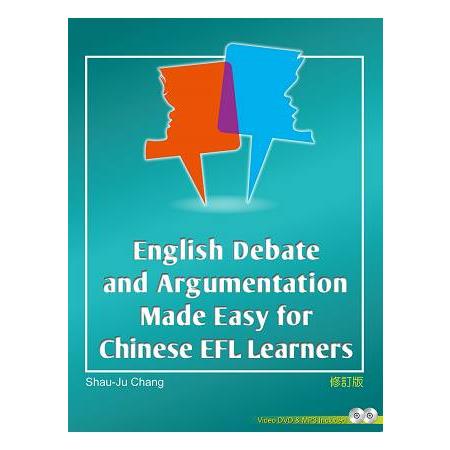English Debate and Argumentation made Easy for Chinese EFL(修訂版)
配送方式
-
台灣
- 國內宅配:本島、離島
-
到店取貨:
不限金額免運費




-
海外
- 國際快遞:全球
-
港澳店取:



內容簡介
This book results partially from a multi-year research project (entitled “Incorporating Debate-related Training into High School English Curriculum”) I conducted from 2007 to 2010 under the sponsorship of National Science Council (now called Ministry of Science and Technology), and partially from my years of experience in teaching English debate to college and high school students in Taiwan. As a teacher, researcher and judge of English debates, I know well the educational values debate holds for learners of English at all levels in advancing their basic language skills, public speaking, critical thinking, organization and researching abilities. At the same time, I am also highly cognizant of the challenges Chinese EFL learners face when engaged in such a culturally unpopular and unfamiliar oral activity,and am convinced that these challenges need to be pointedly addressed if we are ever to see our students benefit from the merits of English debate and thrive in their future academic and professional lives.
It is in that conviction that the book English Debate and Argumentation Made Easy for Chinese EFL Learners was born. The book is arranged into three sections: Generic Critical Thinking Skills, Argumentative Discourse Skills, and Debate Basics. I consider the critical thinking skills included in the book “generic” because I see them as prototypical skills that can be applied to myriad tasks entailing critical thinking. Argumentative discourse skills, on the other hand, are intended to cultivate learners’ linguistic competence in argumentation. Here critical thinking and argumentative discourse skills are seen as the two categories of skills that constitute the essence of any form of argumentation. As a step further, materials included in Debate Basics are,
however, geared toward preparing students for a more formal and advanced form of argumentation,specifically competitive policy debate. The arrangement of the book thus facilitates students of different English proficiency levels in learning argumentation. For the low- and intermediate-level learners, units in sections I and II will meet their needs.
For the highlevel learners and particularly those who are to undertake competitive debate,after finishing units in sections I and II, units in section III are useful in providinga simple but clear blueprint for the essential knowledge and skills entailed incompetitive English policy debate.
Generic Critical Thinking Skills
This section is divided into six units. They are sequenced in an order I consider most conducive to students’ learning of critical thinking skills. The section starts with helping students distinguish facts from opinions. It then teaches them how to detect and clarify vagueness or ambiguity in meaning. By now, students are ready to learn the basic ARE (Argument = Assertion + Reasoning + Evidence)structure of an argument. From there, two types of argument—inductive and deductive—and their respective subtypes are introduced. Just as it is important to learn sound reasoning, it is essential to guard against faulty reasoning.Common fallacies are included and expounded. To further explore the other component of an argument, there is also a unit on use of evidence.
Different types of support, guidelines for using and testing the support, and language for expressing the support are addressed.
Argumentative Discourse Skills
Seven discourse skills fundamental to conducting argumentation are included in this section,and they are Soliciting and Expressing Opinions, Using Fillers and Disclaimers,Using and Challenging Reasons and Support, Agreeing, Disagreeing, Questioning, and Refuting. Useful expressions are introduced for each discourse skill. Among the seven skills, I consider disagreeing, questioning, and refuting more deserving of attention, particularly for students from collectivistic cultures who are lacking practice of those skills. Living in a group-oriented society where
It is in that conviction that the book English Debate and Argumentation Made Easy for Chinese EFL Learners was born. The book is arranged into three sections: Generic Critical Thinking Skills, Argumentative Discourse Skills, and Debate Basics. I consider the critical thinking skills included in the book “generic” because I see them as prototypical skills that can be applied to myriad tasks entailing critical thinking. Argumentative discourse skills, on the other hand, are intended to cultivate learners’ linguistic competence in argumentation. Here critical thinking and argumentative discourse skills are seen as the two categories of skills that constitute the essence of any form of argumentation. As a step further, materials included in Debate Basics are,
however, geared toward preparing students for a more formal and advanced form of argumentation,specifically competitive policy debate. The arrangement of the book thus facilitates students of different English proficiency levels in learning argumentation. For the low- and intermediate-level learners, units in sections I and II will meet their needs.
For the highlevel learners and particularly those who are to undertake competitive debate,after finishing units in sections I and II, units in section III are useful in providinga simple but clear blueprint for the essential knowledge and skills entailed incompetitive English policy debate.
Generic Critical Thinking Skills
This section is divided into six units. They are sequenced in an order I consider most conducive to students’ learning of critical thinking skills. The section starts with helping students distinguish facts from opinions. It then teaches them how to detect and clarify vagueness or ambiguity in meaning. By now, students are ready to learn the basic ARE (Argument = Assertion + Reasoning + Evidence)structure of an argument. From there, two types of argument—inductive and deductive—and their respective subtypes are introduced. Just as it is important to learn sound reasoning, it is essential to guard against faulty reasoning.Common fallacies are included and expounded. To further explore the other component of an argument, there is also a unit on use of evidence.
Different types of support, guidelines for using and testing the support, and language for expressing the support are addressed.
Argumentative Discourse Skills
Seven discourse skills fundamental to conducting argumentation are included in this section,and they are Soliciting and Expressing Opinions, Using Fillers and Disclaimers,Using and Challenging Reasons and Support, Agreeing, Disagreeing, Questioning, and Refuting. Useful expressions are introduced for each discourse skill. Among the seven skills, I consider disagreeing, questioning, and refuting more deserving of attention, particularly for students from collectivistic cultures who are lacking practice of those skills. Living in a group-oriented society where
訂購/退換貨須知
退換貨須知:
**提醒您,鑑賞期不等於試用期,退回商品須為全新狀態**
-
依據「消費者保護法」第19條及行政院消費者保護處公告之「通訊交易解除權合理例外情事適用準則」,以下商品購買後,除商品本身有瑕疵外,將不提供7天的猶豫期:
- 易於腐敗、保存期限較短或解約時即將逾期。(如:生鮮食品)
- 依消費者要求所為之客製化給付。(客製化商品)
- 報紙、期刊或雜誌。(含MOOK、外文雜誌)
- 經消費者拆封之影音商品或電腦軟體。
- 非以有形媒介提供之數位內容或一經提供即為完成之線上服務,經消費者事先同意始提供。(如:電子書、電子雜誌、下載版軟體、虛擬商品…等)
- 已拆封之個人衛生用品。(如:內衣褲、刮鬍刀、除毛刀…等)
- 若非上列種類商品,均享有到貨7天的猶豫期(含例假日)。
- 辦理退換貨時,商品(組合商品恕無法接受單獨退貨)必須是您收到商品時的原始狀態(包含商品本體、配件、贈品、保證書、所有附隨資料文件及原廠內外包裝…等),請勿直接使用原廠包裝寄送,或於原廠包裝上黏貼紙張或書寫文字。
- 退回商品若無法回復原狀,將請您負擔回復原狀所需費用,嚴重時將影響您的退貨權益。









商品評價